Are you a Quiet Speculation member?
If not, now is a perfect time to join up! Our powerful tools, breaking-news analysis, and exclusive Discord channel will make sure you stay up to date and ahead of the curve.
Well, everyone should have seen another ban coming. There was no way that Wizards wasn't going to let their last scheduled banned and restricted announcement go by without doing something about Oko, Thief of Crowns. However, I didn't expect it to go this far. Three cards banned would be a fairly substantial shift by itself, but considering what is getting banned, I'm calling it a seismic shift. Another year, another entirely new Modern.
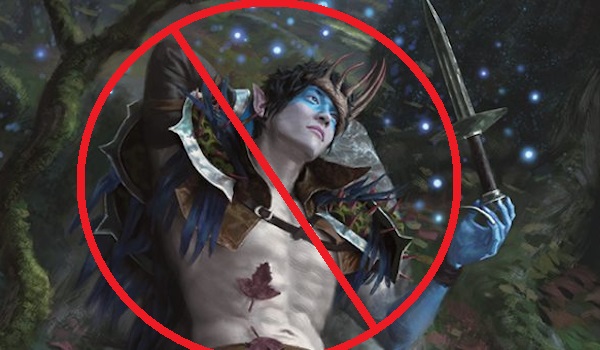
What should not be surprising is the lack of compensating unbans. As I've previously noted, there aren't many plausible candidates. My opinion on Splinter Twin seems to fall in line with Wizards'. And not unbanning the artifact lands makes sense in that Wizards is specifically trying to power down artifact decks.
Oko, Thief of Crowns
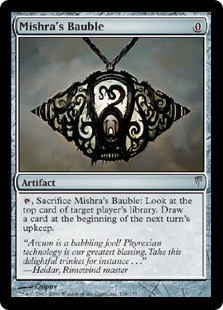 Everyone was expecting Oko to get banned. There didn't seem to be any other option, and Wizards' announcement reflects this fact:
Everyone was expecting Oko to get banned. There didn't seem to be any other option, and Wizards' announcement reflects this fact:
Oko, Thief of Crowns has become the most played card in competitive Modern, with an inclusion rate approaching 40% of decks in recent league play and tabletop tournaments. In additional to having a high overall power level, Oko has proven to reduce metagame diversity and diversity of game play patterns in Modern.
The last few months of 2019 saw him shoot to the top of the format and just sit there. There was no opportunity cost to playing Oko. He made fodder for all his abilities. He never needed to downtick to do something. His starting loyalty was absurd, particularly for a three-mana planeswalker. Wizards admitted that Oko had just slipped through the cracks and they hadn't tested him enough, its high loyalty stemming from a broader issue of overestimating planeswalker vulnerability. Last weekend was the final straw, as GP Austin saw a Day 1 that was dominated by Oko...
...which would eventually translate into a Top 8 of primarily Oko decks. All the props in the world to Ian Birrell getting 4th with a completely stock Jund list, but he was the only player who wasn't riding a stream of food. Once a Top 8 has 26 of 32 (81%) possible Okos present, there's clearly something amiss. The pattern was repeating over at SCG Knoxville, where the Day 2 Metagame was dominated by various Oko decks:
An explicitly Oko-oriented deck was the most played, with lots of other decks running Oko as a package. Simply put, with little opportunity cost to doing so and the substantial upside of snowballing out of control, it was wrong for decks not to run Oko. Some decks splashing Oko included Infect, Amulet Titan, Death's Shadow, and Jund, as reflected in the Top 32:
Oko dodged the finals not for lack of effort. Decks that went over Oko's top did very well, but that's likely because the SCG meta saw the impact of Oko first, and had more time to adjust. Perhaps Modern overall would have ended up in a similar spot, but with Oko already banned in multiple formats, Wizards elected to take one on the chin and ban the planeswalker.
Post-Oko Winners
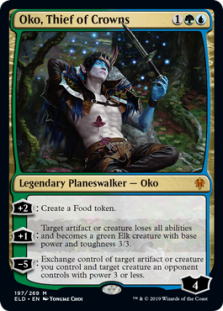 The format as a whole wins, as gameplay and deck strategy should diversify. No longer will it be a version of Standard's snowball-value gameplay. There's also no longer a power card for every single deck to play, which will incentivize innovation in deck configuration.
The format as a whole wins, as gameplay and deck strategy should diversify. No longer will it be a version of Standard's snowball-value gameplay. There's also no longer a power card for every single deck to play, which will incentivize innovation in deck configuration.
Any deck that was looking to actually do something with non-ETB artifacts and creatures also wins. Oko rendered big creatures and splashy artifacts useless by making them 3/3 Elk. Death's Shadow was initially seen as an answer to Urza, but Oko pilots have since turned plenty of 11/11s into Wild Nacatls. Death's Shadow is an obvious beneficiary as a result. Primeval Titan was very strong even with Oko around, but Oko made it far less threatening; the Titan is unleashed now, too. On a more somber note, prison pieces will come back into vogue. It didn't matter if Ensnaring Bridge was in play when it was just going to become an Elk, and the same follows for any artifact that wasn't part of the 0-1 CMC value engine common among Urza decks.
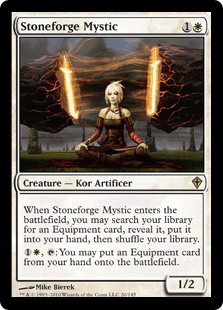 The largest individual winner is Stoneforge Mystic. Mystic hasn't yet had the chance to take off in Modern, and Oko tucked it further away. Fair cards with many possible homes take time to catch on, as did Jace, the Mind Sculptor. Oko forestalled the brewing process by rendering equipment ridiculous. Without it, Mystic may finally have a chance to spread her wings.
The largest individual winner is Stoneforge Mystic. Mystic hasn't yet had the chance to take off in Modern, and Oko tucked it further away. Fair cards with many possible homes take time to catch on, as did Jace, the Mind Sculptor. Oko forestalled the brewing process by rendering equipment ridiculous. Without it, Mystic may finally have a chance to spread her wings.
Post-Oko Losers
All the decks that were playing Oko take a hit. However, the loss won't be felt equally. UGx Urza decks will almost certainly disappear; the reasons to play green were Oko and Gilded Goose, the latter present mainly to pump Oko out faster. Simic Urza should revert to Grixis Whriza, which may actually benefit considerably for the same reasons I mentioned about artifact decks above.
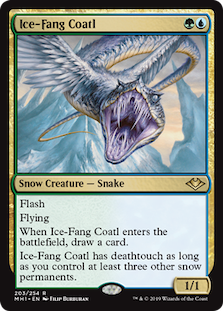 Oddly, I think the biggest loser will be Bant Snowblade. Snowblade was starting to gain some traction as an anti-Urza deck in the run-up to SCG Knoxville, and didn't do too badly in Austin either. However, this was based on it being a better Oko deck rather than its own merits as a deck. Snowblade had more ways to accelerate into Oko while playing less air than a typical Urza deck. Playing fewer artifacts meant dodging typical hate.
Oddly, I think the biggest loser will be Bant Snowblade. Snowblade was starting to gain some traction as an anti-Urza deck in the run-up to SCG Knoxville, and didn't do too badly in Austin either. However, this was based on it being a better Oko deck rather than its own merits as a deck. Snowblade had more ways to accelerate into Oko while playing less air than a typical Urza deck. Playing fewer artifacts meant dodging typical hate.
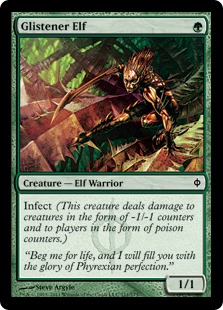 The deck also enjoyed turning its mana dorks into actual threats. Also, Elking a friendly Spell Queller and then bouncing Queller with Jace or Teferi meant that the Quelled card would stay exiled forever. With Oko gone, Bant is back to being filled with dinky creatures and uninspiring payoffs, as it was before Throne of Eldraine. Stoneblade will still be around, but its shell needs an overhaul.
The deck also enjoyed turning its mana dorks into actual threats. Also, Elking a friendly Spell Queller and then bouncing Queller with Jace or Teferi meant that the Quelled card would stay exiled forever. With Oko gone, Bant is back to being filled with dinky creatures and uninspiring payoffs, as it was before Throne of Eldraine. Stoneblade will still be around, but its shell needs an overhaul.
The other big loser is Infect. Ever since Gitaxian Probe was banned, Infect has struggled. The deck never goes away completely, but without the information advantage of Probe, it just can't maneuver past all the removal and discard in Modern. Oko gave Infect new legs via an alternate win condition immune to typical Infect hate by virtue of its focus on value and stretching of enemy resources. Infect will now default back to its uninspiring pre-Eldraine configuration.
Mox Opal

While some have speculated on Mox Opal getting banned for years, I've always disagreed. The problem was never Opal itself, as evidenced by Affinity. Opal needed a lot of setup and was frequently bad on its own. It was in the presence of overpowered engine cards that Opal became unfair. Even without Opal around, Ironworks would have been too good thanks to how absurd a mana engine it is. Meanwhile, there's no reason to play Affinity or similar artifact decks without the acceleration of Opal. They're too fragile easy to hate out otherwise. However, Wizards decided that Opal being a main component of Oko decks was the final straw:
As a source of fast mana in the early game, Mox Opal has long contributed to strategies that seek to end the game quickly and suddenly, whether with explosive attacks, one-turn win combos, or by locking out the opponent with “prison” elements. While none of these decks previously warranted a ban of Mox Opal, it has historically been a part of decks that approached problematic impact on the metagame or did indeed necessitate other bans.
Wizards is concerned about Urza just coming back. They're even more worried that Opal will be a greater problem in the future.
As the strongest enabler in the recent Urza artifact decks, and a card that has been concerning in the past and would likely cause balance issues in the future, Mox Opal is banned in Modern.
Reading between the lines, Wizards is concerned about future cards proving unsustainable alongside Opal, and wanted to get ahead of the problem. I think that means they're worried about Underworld Breach combo, a deck which is almost certainly dead before it ever got a chance to live. It may also imply another set with pushed artifacts in the pipeline.
Affinity is Dead
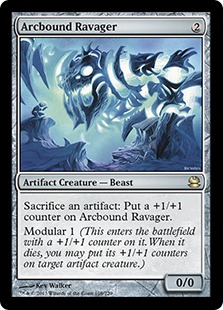 And with that, Affinity is finally dead. It hasn't done well for quite some time, but losing Opal is the final nail in the coffin. There's simply no reason to play an aggro deck that dies to not only Supreme Verdict but to Stony Silence, especially when it's no faster than other aggro decks. Humans sounded the knell by being a very similar deck that was more disruptive and resilient, but Affinity stuck around in some capacity as a metagame deck. Hardened Scales may remain, since it has green acceleration, but it's a tough sell. It will take some very pushed artifact creatures or synergies to make construct aggro a thing again.
And with that, Affinity is finally dead. It hasn't done well for quite some time, but losing Opal is the final nail in the coffin. There's simply no reason to play an aggro deck that dies to not only Supreme Verdict but to Stony Silence, especially when it's no faster than other aggro decks. Humans sounded the knell by being a very similar deck that was more disruptive and resilient, but Affinity stuck around in some capacity as a metagame deck. Hardened Scales may remain, since it has green acceleration, but it's a tough sell. It will take some very pushed artifact creatures or synergies to make construct aggro a thing again.
Many fringe artifact decks also look significantly worse. Lantern (thankfully) died years ago, but this also means Cheeri0s is gone. The combo only generated mana by looping Opal, and trying to make Mox Amber work in its place takes Cheeri0s into a very different combo space.
Long Live Urza
Given that artifact decks are taking such a huge hit, the hope is that the targeted deck will also go. But I don't think that banning Opal will hurt Urza that much. He'll just roll with the punches and adapt. According to Wizards:
We considered options that would further weaken Urza-based artifact decks, while still allowing for decks based around that general strategy. Ultimately, we determined that banning Mox Opal was the correct option.
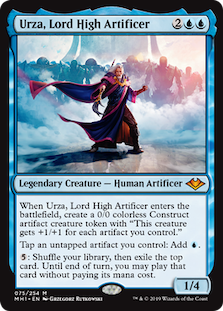 However, Urza, Lord High Artificer doesn't need Opal. Simic Urza decks did, because they were all about getting out a powerful engine quickly, be it Emry, Urza, Oko, or Karn. Gilded Goose coupled with Opal was the key to getting them online before opponents could respond, which was the key to Simic's success.
However, Urza, Lord High Artificer doesn't need Opal. Simic Urza decks did, because they were all about getting out a powerful engine quickly, be it Emry, Urza, Oko, or Karn. Gilded Goose coupled with Opal was the key to getting them online before opponents could respond, which was the key to Simic's success.
However, Grixis Whirza was already slower than Simic. Its main plan was as a prison deck, and all it needed to do was get out the right lock piece eventually. It can also combo win from nowhere. Earlier is obviously better than later, but it isn't necessary; Opal's greatest contribution was how efficiently it helped Urza empty its hand for Ensnaring Bridge, which is only relevant against hyper-aggressive decks. Against everything else, Whirza was playing a slower reactionary game anyway, so the Opals were primarily replacing lands. Whirza will just run an extra land or two and use the extra slots for either another artifact or some more interaction. Urza is still an absurd card, so I predict that all Wizards is dong is kicking the can down the road.
Mycosynth Lattice
Finally, there's the truly unexpected banning. I couldn't find any writers calling for banning Lattice before today, didn't see any discussion threads about it, and would never have expected such a ban to happen even if there were said calls. Mycosynth Lattice just doesn't do anything. The only reason for banning it is Karn, the Great Creator's non-symmetrical effect. However, Wizards thought lowly enough of the combination to pull the trigger.
This combination, popular in Eldrazi and other Tron decks, can completely lock the opponent out from casting further spells. While decks featuring this combination often win in other ways, the deckbuilding cost to include this interaction is low, causing it to show up more often than is fun in competitive play.
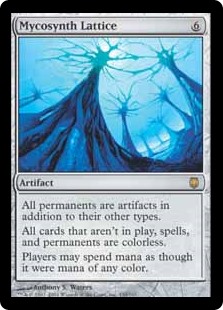 I don't disagree with the reasoning. Getting locked out of the game is horrible, but the deterministic nature of the Lattice lock is much worse. Against typical prison locks, you're only truly out of the game when you have no answers left in your deck. Lattice lock offers a one-time window to answer. Once Karn and Lattice are on the board, the only source of mana the opponent could have is Simian Spirit Guide. Unless enough creatures are on the board to kill Karn, that's the end.
I don't disagree with the reasoning. Getting locked out of the game is horrible, but the deterministic nature of the Lattice lock is much worse. Against typical prison locks, you're only truly out of the game when you have no answers left in your deck. Lattice lock offers a one-time window to answer. Once Karn and Lattice are on the board, the only source of mana the opponent could have is Simian Spirit Guide. Unless enough creatures are on the board to kill Karn, that's the end.
I did not think that fact was enough for Wizards to ever take action. I suspect that, due to the Simic Oko decks, Wizards was seeing the lock come up far too much. With Oko leaving the format, the lock would have necessarily become far less frequent since his deck is going away. However, Wizards decided that they wanted to be sure. On Twitter, LSV called the Lattice ban "forward-looking." I see the point, and it is better to strike while the iron is hot. That said, I don't think I've ever been more surprised by a banning before. Even the Twin ban was less surprising, despite the reactions at the time.
Modern Moves On
With a major pillar removed and several recent distortions gone, Modern is once again wide open. The incoming set will further muddy the waters. We'll just have to wait and see how this all plays out.





Good thing that Modern(daresay: many competitive players in general) are going to continue to jam ubiquitous cards and/or decks to the effect of homogenizing future metagames.
The Opal ban was overdue. Underworld Breach is the tip of the iceberg—a lot of ink has been spilled over the years about how cards, like mox constrain design.